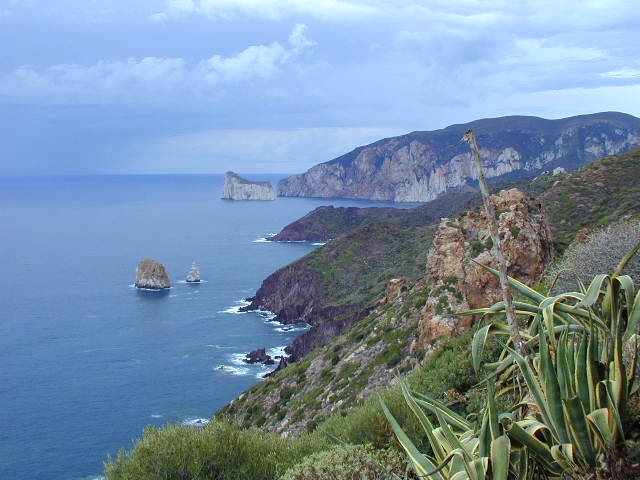zurück

Kueste von Gonnesa, Masua, Nebida Pan di Zucchero
Pan di
Zucchero (Sugarloaf) is a striking natural landmark located on the
western coast of
Sardinia, Italy, near the town
of Iglesias in the
Sulcis-Iglesiente region. It is
a massive limestone rock
formation that rises dramatically out of the sea, standing about
133 meters (436 feet) high. The
name "Pan di Zucchero," meaning "sugarloaf," refers to its shape, which
resembles a traditional cone-shaped sugar loaf.
Key Features of
Pan di Zucchero:
1.
Geography and Location:
- The
Pan di Zucchero rock is
situated just off the coastline
of Iglesias, in the
Sulcis Peninsula of
southwestern Sardinia.
- It rises directly from the sea, making
it a distinctive and
iconic landmark. The
surrounding landscape is rugged and dramatic, offering breathtaking views of
the Mediterranean Sea.
2.
Formation and Geological Significance:
- Pan di Zucchero is made of
limestone, and its
distinctive shape is the result of
erosion and weathering
by both water and wind over thousands of years.
- The formation of Pan di Zucchero is a
geological marvel, as it
stands isolated in the sea, with steep cliffs and sharp features that make
it appear almost like a natural sculpture. Its
geological history
reflects the tectonic movements
of the region, which shaped the Sardinian landscape.
3.
Pan di Zucchero: A Seaside Icon:
- The landmark is located near the
village of Masua, and it
has become one of the most recognized natural attractions in
Sardinia. The rock is
visible from various spots along the coastline, and its
dramatic silhouette
against the sea is a popular subject for
photographers and nature
lovers.
- It is often compared to
Brazil's Sugarloaf Mountain
because of its similar shape, although it is smaller and surrounded by the
Mediterranean Sea.
4.
Natural Environment and Wildlife:
- The surrounding area is rich in
natural beauty, with
wildlife and
plant life typical of the
Mediterranean coastal regions.
You may find various species of
wildflowers, cacti,
and shrubs growing around
the rocky landscape.
- The rock and nearby cliffs are also
home to a variety of seabirds,
including seagulls and
cormorants, who nest in
the crevices of the cliffs.
5.
Pan di Zucchero and Its Cave (Grotta
di Pan di Zucchero):
-
Grotta di Pan di Zucchero
is a cave located at the
base of the rock. The cave can be accessed by boat and is a popular
destination for cave exploration.
The entrance to the cave is through a
large arch in the rock,
leading to an impressive cavern
with high ceilings and a sense of mystery.
- The cave also offers the opportunity
for diving or
snorkeling around the
rock formations, as the waters are crystal clear.
6.
Activities and Exploration:
-
Boat Tours: A popular way
to experience Pan di Zucchero is by taking a
boat tour along the
coast, where visitors can approach the rock and admire its towering presence
from the sea. Boat tours often include stops at other nearby coastal
features, such as cliffs and caves.
-
Hiking and Scenic Views:
While visitors can’t climb Pan di Zucchero itself, there are
hiking trails nearby that
offer panoramic views of
the rock from the land. The trails lead to cliffs with stunning vistas of
the Mediterranean coast and the island’s rugged landscapes.
-
Photography: The location
is a favorite for photographers,
with its striking appearance and dramatic scenery making for excellent photo
opportunities. Sunrise and sunset are especially popular times to capture
its beauty.
7.
Proximity to Other Attractions:
-
Iglesias: The nearby town
of Iglesias is a charming
historical town with rich mining heritage and well-preserved architecture.
Visitors can explore its narrow streets, churches, and squares before
heading to Pan di Zucchero.
-
Grotte di Su Mannau: Not
far from Pan di Zucchero, the
Grotte di Su Mannau is a significant
cave system in the
region, known for its impressive
stalactites and
stalagmites. It is one of the most extensive cave systems in
Sardinia.
-
Porto Flavia: Another
nearby attraction is Porto Flavia,
a historic mining port, which can be reached by a scenic walk. The
port was built into the
cliffs and offers dramatic views of the coastline.
8.
Best Time to Visit:
- The best times to visit Pan di
Zucchero are during spring
and autumn, as the
weather is mild, and the crowds are smaller compared to the summer months.
- Summer can be quite hot, but if you
prefer visiting during this time, be sure to bring water and sunscreen,
especially if you plan to hike.
Summary:
Pan di Zucchero is an iconic natural landmark on the southwestern coast
of Sardinia, standing at 133 meters
above the sea and offering dramatic views. The
limestone formation is a
prime example of the island's geological beauty and is a must-visit for nature
lovers, photographers, and anyone exploring Sardinia’s rugged coastal scenery.
Visitors can enjoy activities such as
boat tours, hiking,
and cave exploration, as well
as marvel at the unique landscape surrounding the rock.
 26.07.25 Copyright Dirk
Rauschenbach Koelnerstrasse 293 51702 Bergneustadt
Datenschutzerklaerung 02261 9788972 Mail ccooly(
at) web.de
26.07.25 Copyright Dirk
Rauschenbach Koelnerstrasse 293 51702 Bergneustadt
Datenschutzerklaerung 02261 9788972 Mail ccooly(
at) web.de
 Safaris
Bergsteigen
Wandern
Inselwandern Weltweit
Safaris
Bergsteigen
Wandern
Inselwandern Weltweit
 Europa
Inselwandern
Europa
Inselwandern
 Städtewandern
Städtewandern
 Paintings
Paintings Dirk Rauschenbach
Dirk Rauschenbach
 Safaris
Bergsteigen
Wandern
Inselwandern Weltweit
Safaris
Bergsteigen
Wandern
Inselwandern Weltweit
 Europa
Inselwandern
Europa
Inselwandern
 Städtewandern
Städtewandern
 Paintings
Paintings Dirk Rauschenbach
Dirk Rauschenbach

![]() 26.07.25 Copyright Dirk
Rauschenbach Koelnerstrasse 293 51702 Bergneustadt
Datenschutzerklaerung 02261 9788972 Mail ccooly(
at) web.de
26.07.25 Copyright Dirk
Rauschenbach Koelnerstrasse 293 51702 Bergneustadt
Datenschutzerklaerung 02261 9788972 Mail ccooly(
at) web.de